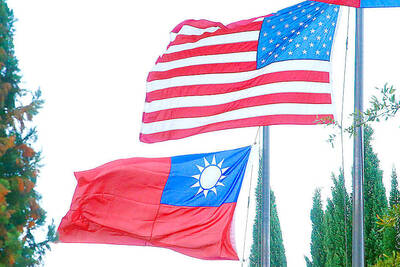China withdrew one of three ships engaged in a standoff with Philippine vessels in a disputed area of the South China Sea yesterday as both sides pursued talks to defuse the dispute.
The row underscores broader tension extending back decades over jurisdiction in areas in the South China sea believed to be rich in oil and gas and crossed by important shipping lanes.
“China’s embassy in Manila informed us they have a different mission for one of the three ships,” Philippine foreign affairs spokesman Raul Hernandez told a local radio station yesterday.
Philippine Foreign Affairs Secretary Alberto del Rosario said both sides put forward proposals to resolve the dispute, but no agreement had yet been reached.
He gave no details on the proposals, but said he was scheduled to meet Chinese Ambassador to the Philippines Ma Keqing (馬克卿) again yesterday.
“We were able to succeed with moving forward with a few steps, but there are other matters that remain outstanding so we hope to continue to discuss this,” Del Rosario told reporters.
On Sunday, Manila dispatched its largest warship, a US Hamilton-class cutter, to the Scarborough Shoal, about 125 nautical miles off the main Philippine island of Luzon, after a navy aircraft spotted eight Chinese fishing boats docked in the area.
Philippine security officials found one of the boats carrying illegally collected coral, giant clams, and live sharks and were about to detain the fishermen when they were blocked by two Chinese surveillance vessels.
A third Chinese vessel arrived on Thursday at the shoal, known in the Philippines as Panatag Shoal and in China as Huangyan Island (黃岩島). Manila tried to ease tension by replacing its warship with a coast guard cutter.
Philippine Navy chief Vice Admiral Alexander Pama said the Philippine warship was on alert and stationed at a nearby port for refueling and restocking of provisions.
“The guidance to us was not to raise the level of tensions, if there are any,” Pama said.
The two sides traded diplomatic protests on Wednesday over the row, the latest in a long list of conflicting claims over islands, reefs and shoals that pit China against Taiwan, the Philippines, Vietnam, Brunei and Malaysia.
At a regional summit in Phnom Penh this month, Manila sought a regional meeting to discuss the sea disputes, but China rejected “internationalization” of the disputes, preferring one-on-one talks.

Taiwan is projected to lose a working-age population of about 6.67 million people in two waves of retirement in the coming years, as the nation confronts accelerating demographic decline and a shortage of younger workers to take their place, the Ministry of the Interior said. Taiwan experienced its largest baby boom between 1958 and 1966, when the population grew by 3.78 million, followed by a second surge of 2.89 million between 1976 and 1982, ministry data showed. In 2023, the first of those baby boom generations — those born in the late 1950s and early 1960s — began to enter retirement, triggering

ECONOMIC BOOST: Should the more than 23 million people eligible for the NT$10,000 handouts spend them the same way as in 2023, GDP could rise 0.5 percent, an official said Universal cash handouts of NT$10,000 (US$330) are to be disbursed late next month at the earliest — including to permanent residents and foreign residents married to Taiwanese — pending legislative approval, the Ministry of Finance said yesterday. The Executive Yuan yesterday approved the Special Act for Strengthening Economic, Social and National Security Resilience in Response to International Circumstances (因應國際情勢強化經濟社會及民生國安韌性特別條例). The NT$550 billion special budget includes NT$236 billion for the cash handouts, plus an additional NT$20 billion set aside as reserve funds, expected to be used to support industries. Handouts might begin one month after the bill is promulgated and would be completed within

NO CHANGE: The TRA makes clear that the US does not consider the status of Taiwan to have been determined by WWII-era documents, a former AIT deputy director said The American Institute in Taiwan’s (AIT) comments that World War-II era documents do not determine Taiwan’s political status accurately conveyed the US’ stance, the US Department of State said. An AIT spokesperson on Saturday said that a Chinese official mischaracterized World War II-era documents as stating that Taiwan was ceded to the China. The remarks from the US’ de facto embassy in Taiwan drew criticism from the Ma Ying-jeou Foundation, whose director said the comments put Taiwan in danger. The Chinese-language United Daily News yesterday reported that a US State Department spokesperson confirmed the AIT’s position. They added that the US would continue to

The National Development Council (NDC) yesterday unveiled details of new regulations that ease restrictions on foreigners working or living in Taiwan, as part of a bid to attract skilled workers from abroad. The regulations, which could go into effect in the first quarter of next year, stem from amendments to the Act for the Recruitment and Employment of Foreign Professionals (外國專業人才延攬及僱用法) passed by lawmakers on Aug. 29. Students categorized as “overseas compatriots” would be allowed to stay and work in Taiwan in the two years after their graduation without obtaining additional permits, doing away with the evaluation process that is currently required,